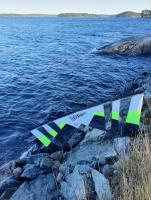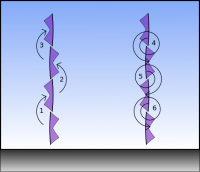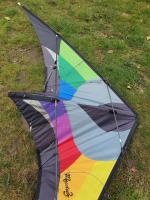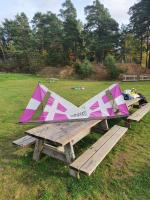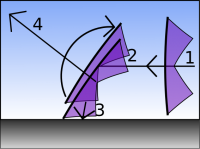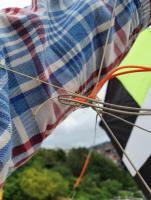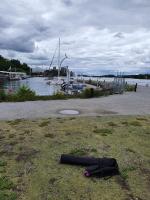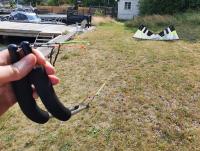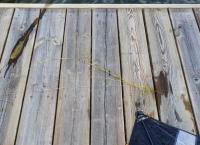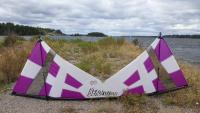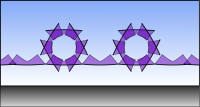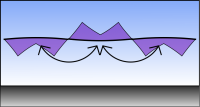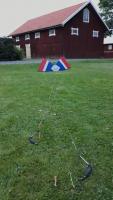-
Posts
580 -
Joined
-
Last visited
-
Days Won
27
Content Type
Profiles
Forums
Gallery
Events
Downloads
KL Shop
Blogs
Articles
Classifieds
Community Map
Everything posted by Exult
-
Well, hello from (somewhat nearby) Sweden. I have two Kymeras (no tail weights any longer). If any C-clip positions have moved (i.e if I have repaired them or not) I don’t know, but I guess that I could have look to determine if they haven’t been repaired yet (have their original positions). The top spreader would be easy to measure. May I ask which bridle leg(s) that is/are unknown?
-
It sounds as if you already can go quite low in winds by the Prism 3-D. Have you considered a more modern full size sensible/non-extreme high end dual line trick kite (...that can also do some precision...) for lowish medium winds? If necessary using the old ones for a while (not so bad see the below video recommendations) and save up for a well researched one (there is always the opportunity later to do spending). (And I unfortunately don't know anything about the HQ Flow - might be an excellent one) My path when returning to kites after the 15 year break was first to get the Prism kites I had been drooling over as a student. Mainly because I found them discounted at ~50% so I got an Elixir, Illusion, Alien and later the 4D... Now they didn't get very much use with time except for initially (with the exception of the 4D - great for learning to reduce inputs and very portable) and possibly the Alien. Well the Alien could do double axels (never managed to transfer them to other kites though) and offered great leading edge launch practice (i.e. was very difficult to launch in that way) so that kite's personality did contribute but wasn't what I build further trick practice on. The first newer kite model from this millennium was an HQ Maestro 3. It was different from what I was used to, needed much input to do square turns and felt "chunky", so I didn't like it and used it for slightly more risk taking almost reckless trick practice. Only after I had got hold of my (bring to a deserted island) HQ Infinity I realised that they resemble (the feel, not the look) each other quite much. I believe that the one I didn't initially like paved the way for the favourite one. Sometimes when you feel uncomfortable/out-of-control you are just learning new things and possibly you just don't know it yet (polishing skills is something different though). What worked for me at least was something new and full-size and then gradually accepting the different feel of the kite(s). You probably know of these videos, but since you mentioned that you had a Flexifoil Stranger and a Psycho-like kite: (Now is a good time for those potato crisps and the beer and a pen and paper) About the possibility to get a quad I'd say that it opens up tight spots when you get used to them. Today I have no problems with quads on a narrow jetty, but I wouldn't do it with a dual (or perhaps it is the (failed) slack line tricks over water that is the real problem?).
-
Regarding starting again, buying kites, low wind and no nearby beach: To be near a spot where one can practice is of importance or rater getting to the field/parking/jetty can't cost much extra time to get any regularity of the practice sessions. So use what is close and don't care what what others think (and if you can't avoid thinking of it, think that it is way better than other popular pastimes such as streaming series and consuming fatty “potato flakes” and beer): While I have never tested any of the kites you have I can only compare to my experiences of returning to kites when the children had (mostly) grown up: I learned new stuff with the new (about >15-year newer) models (initially 2-line then 4-line) I then got hold of. "Would this or that kite be the one that first gained me some insight/new trick" reasoning perhaps led to a few redundant kites. Well redundant in the sense that I didn't have time to "fully" learn from each one of them, but I still don't want to part from them. On the other hand the only set of same-model-but-different-wind-ranges (Rev B-series std/half/full vent) allowed for continuity and consistent practising in any wind. If you stop progressing get something new or start to use something already available in a new way (short lines, new trick, two kites, precision...). Regarding the lack of wind in the new city, well a low wind session is a practice opportunity: https://www.youtube.com/watch?v=pgwdJlX2ZfA&t=1995s (Prism: The Advanced Way to Fly, Light Wind Skills) https://www.youtube.com/watch?v=nXavCyyJCog&t=890s (Prism : Freestyle Pilot, Light Winds) Practice stuff like this and become a more complete kite pilot. E.g polish a series of pop-up launch followed by belly landing (for dual lines) and make it shine. Also low/no wind means less turbulence which can open up new smaller fields. Though I’ve been on a bit of a kite break myself I wish you welcome here and Good Luck.
-
Looking for trouble - found the 540 deg backwards ladder down The Rev B-series full vent with 4wrap spars. The setting Back to for the day windy pier. Almost all boats had been moved from the harbor (end of season) - there were no persons there. For the last three weekends I have not left the garden at home, since I have been handling the (fire)wood after having had almost all branches of an old(~150 year) common ash tree taken down. I.e. no kiting in a while. The session The main drill of the day. Today I used the full vent B-series with four wrap spars. The new main drill of the day was a backwards ladder down with 540 deg wing tip pivots. It was a good drill that even made the kite fall out of the sky a few times. Yes this was the case at least for the 540 deg backwards pivots around the right wing tip. The 180 degrees pivots worked, the 360 worked rather OK, while the (uncommon) 540 deg turned out to be a challenge. A bit surprising, but I guess that when leaving your usual “autopilot stuff” you find the challenges. I’ll should also try this in a future more medium wind session where the grip on the handles can be more relaxed. The method The 540 deg backwards wingtip downwards were made using the familiar method/sensation of actively flying the wing backwards during the wing tip pivot and letting the increased pressure fill you hand during the pivot. The pressure should stop abruptly just as the pivot stops abruptly. Non-intentional landing. The brake lines went around/over the edge of the pier, thus effectively shortened, so it didn’t take off even with the LE up. How is it compared to you other gliders (if not to early to form an opinion)?
-
Yes we did, mostly in the former Eastern parts of Berlin during our visit. Also did try the suggested kite contact (by e-mail), but there was unfortunately no reply. Much construction work going on. Also much space even in central parts of the town. The future museum. It was still nice and warm. Never knew that curry sausage was such a big thing (however quite tasty). 🙂
-
[whining]Gradually the small field is turning to something else (a storage area?) - now seven stationary objects are on it and plenty of semi mobile benches/tables, that only a group of persons can move, appear at random places. This in an area where there are few (no) other options (large fields or fields close to water) for say 20m/66ft dual line kiting.[/whining] I reached for a duallie (HQ Maestro 3). Time to maintain these skills as well. Authentic sea weed (from 2016?) and a repaired nose. I have much left to polish and several tricks to work on. A bit bothered about all the stuff on the field when running backwards/forwards and when recovering after failed tricks. OK, this quad has been in this topic before... Some of the things addressed: backwards ladder down, horisontal reverse flying out from the centre of the wind window and catch and throw in the non-light wind. The field/obstacle course here is not so much of a problem with a quad (exception being 360-ies on 15m/49ft lines, but the wind was not low enough today for this anyhow).
-
Good endurance! ...Now why don't I have any good looking red kites?...
-
Again, the Rev B-series, this time the mid-vent on 25m lines (82ft). Actually on a beach today, so very little ground contact not to have sand in the end caps. The main drill of the day. Themes of the session: Focus this time on... really feeling the lines (or occasionally remind myself to) - Not only see the kite and summarize the move by a feel(/feeling?)., but focus on feeling the lines and think about the handles movement. Identify the input one is doing. Work on doing the ladder down wing tip pivots backwards while minimizing the end/stop wobbling, Method: mix in forwards ladder up wing tip pivots (easier) to get feeling of the the powered drive when flying the wing through the pivot. Then preserve the feeling when doing backwards/down pivots. Think of the handles and think what “they” did the last time when the move went well so that you can increase that component(s). And yes, the drill is cyclic.
-
Sometimes patience is really rewarded! B.t.w. he first time I saw my wife was on a downhill ski trip when I also did some limited ski traction kiting. I still have the kite (a 5^2 Peter Lynn Peel - my first foil (guess that one should have started with a small trainer foil, but budget was really limited at the time)), but I haven’t used it since. How serious! Myself, I'm on a diet - never more than two kites and not (preferably) more than one purchase a year. There is so much to learn from one kite. It is a start (like feeding wild birds with breadcrumbs in your hand), but the real take off would be when your sons borrow the kites to go flying/piloting with friends. Funny, after the snap stall the axle was the first trick for me. To do the Lazy Susan, that took a loong time. Good luck with your return to kiting!
-
The almost 45 deg ground contact move (without a name?) Kite: Rev B-series Std Wind: Fluctuating between winds suitable for the Rev B-series std and mid vent Frame: 3 wrap tubes in the LE and 2PT in the downspars Lines: 8.2m (27ft) and 15m (49ft) Handles: 13 inch During the weekend I had been watching two videos where the short outer edge of the kite makes a quick ground contact: https://kitelife.com/forum/topic/6210-whats-your-favourite-video-to-introduce-the-dark-side/?do=findComment&comment=47628&_rid=10687 (JB on Rev B2 - Great video !!) https://kitelife.com/forum/topic/8174-jb-eli-albany-bulb/?_rid=10687 (Here JB and Eli Russel "are" “Bad to the bone”) My attempts on this move (e.g. at o:39 in the first video) has been rare, single tries and a little clumsy - my to go ground contact has been with the wing tip. I have also not known/decided of the ground contact is a 45 deg side slide into the ground or if the hole kite is partly lowered downwards into the ground. Especially in the latter video he kite is lowered so I decided to go into that direction for this session. Method (opinion might change when I learn more of this move). This was how I did/thought about it today: Fly the kite parallel to the ground. Add some brake on the top side to rotate the kite by almost 45 deg. With the lower handle drag the hole kite downwards so it briefly/gently touches the ground. Fly off with LE first Doing two 45 deg ground contacts directly after each other demanded greater control when powering up the sail/taking off after the first ground contact, so it was good training.
-
How odd! So I guess that this upper "line-spreader" is under tension to keep things fixed? This should cause the leading edges to be bent slightly inwards?
-
When kite piloting occupies your mind outside the field between the sessions. After the session: What do I want to continue with the next session? Any insights that should be remembered? Did I miss rehearsing anything that has not been practiced in a while? Between/before sessions: Watch videos and read forum posts - is there a new move/sequence/style that one can attempt to borrow? Sometimes figure on hand movements, both on things that you can do and want to learn. Are there similarities/differences between different moves that can be used to vary the moves? Is there a new sequence that can prevent one from pŕacticing "only" the std things in the ordinary way?
-
Kite: Rev B-series Std Wind: Between the Rev Indoor and B-series Std Frame: 3 wrap tubes in the LE (guess that I was lazy enough not to swap them) and 2PT in the downspars Lines: 8.2m (27ft) Handles: 13 inch After a visit to the dentist I looked for distraction, so that I wouldn't think of any pain when the anesthesia ceased. I just happened to had packed the kite bag in the car before going to the visit. Could find a small space by the sea. Had to stop frequently in good time not to worry passers by. Half the wind window was OK wind from the sea and the other half was behind a small tree with sparse branches. The main "mission" was just to do "the normal stuff" and not try to be affected by the conditions. Sometimes this tangle happens when doing catches and glides. How to avoid it? Make the sleeved loop shorter or tape around the sleeving knot (or just remove the sleeving altogether some would say)? When the wind is tangential (somewhere) to the a bit rounded pier I instead use the 15m (49ft) line set here.
-
👍👍👍 That is right! Safety always comes first! ⛑️🦺🥽
-
Thank you for your detailed reply regarding the glider kites! Cool to involve vertical winds! However there are some aspects of this that I totally can be without. The following is not my cup of tea...:
-
Nexus adjustment At least the Nexus 2.0 comes with a std prussic knot on a pig tail tow point bridle adjustment according to the Prism website (Main > Our Kites > Dual_Line Framed Kites > Nexus 2.0 > Support > Nexus 2.0 Manual > Bridle Overview). It also seems to be a simple but clever limitation of the available range by two overhand knots on each side of the pigtail ("1-1/2in apart"). General adjustment On any bridle all adjustments should be small, like 1cm/0.5in or less. When finished with the adjustment sliding, hold the prussic and pull the pigtail to lock the prussic and fix the position. Often the factory default setting is marked with a permanent marker dot. Four general rules for dual line kite bridle adjustment that work for me: Do nothing - keep it at the default factory position for most winds. In higher winds to still have the stalls available - nose back. If you have to, to get the kite going in light wind - nose towards you. In very high winds - nose towards you to relive pressure (or get your vented quad) The nose away from you comes with the bonus of keen small radius turns. The nose towards you comes with the penalty of large radius turns. Test the nose back setting in higher winds with a (snap) stall or a side slide. My recommendation to you is to not think so very much about this for your first session with your new Nexus. Instead chose a medium or somewhat lower wind day that will work with the factory default setting. Try the kite with the lines on the field and see if there is some other issue that limits your sessions. Good luck! (Nope, I haven't got a Nexus - Only some older Prism duals)
-
I haven't even seen a glider kite in real life so they are somewhat exotic to me. Therefore I have some questions (but not so much time for an actual new branch of kiting or any purchase). Where does one buy iFlites in Europe? During a session, what does one aim for? Flying (3D) figures? A calm soft "natural" relaxing flow to calm music for anti stress purposes? Rising/diving quickly? Quick turns on demand? Fighter kite practice indoors? The eternal indoor quest - finding the space. At the local tennis facilities a few years ago I once managed to get a few minutes indoor kite testing for free (they were highly skeptic). Indoors outdoors is my way mostly.
-
OK, now something for your Saturday beach day (and many sessions to come). Work on a couple of things: Side slides Bicycle rotations Power-ups/deadstops Small figures, like a square, rhomb, triangle... Side slides Do an inverted hover close to the edge of the wind window and just drift downwind. When you can do this (not necessarily on Saturday), try speeding it up by driving the kite sideways by pulling mostly on the front side handle. Pulling like this hard will cause the powered kite to turn following the now curved LE. To counteract this and continue in a straight line, apply brake on the trailing side and release brake on the leading side. Bicycle rotations Keep the center in one place. Power-ups/deadstops I see this as a two stroke thing (the thumbs should be on top of the handles): Pull on all four lines to speed up. Throw out your thumbs/arms in front of you to stop the kite. It should be like if you are hitting something in front of you with your thumbs while your arms extend front/downwards. Small figures, like a square, rhomb, triangle... You don't want to look like you just are having problems in making the kite fly? Include figures! It is also a good over all practice in control. Let us know how it goes! Yes a last (important) tip. With a rev-like kite don't use unnecessarily short settings on the top line, instead use one of the outermost knots. To find a good trim point on your upper leaders you can test it by doing a LE up hover (except for in the lowest of winds). Extend the top line setting until you can barely keep the hover.
-
This session I tried a new place. I had gotten permission to be on a neighbor’s property. I could fit in the 8.2m lines (27ft). Unfortunately the wind had a habit of changing direction almost 180 deg due to a long nearby island blocking the wind. Yes, towards the end of the session the kite ended up in the water. The Rev B-series Std. Temporary mid setting on the top leaders for testing purposes. If this session had a theme (apart from some usual maintenance practice) I'd say it was trying to mimic dual line half axels and its possible resemblance to quick 180 deg (team) turns. I tried "shortening the top lines" for this. Earlier I have also tried bridle less piloting when doing dual line like half axels. I'd say that I’m still learning though. Successfully fishing algae goo by application of the tangle method.
-
You can go backwards and, I assume, forwards. You can hold a hover in any direction. You can turn in some manner. From this you should be able to start/land with the leading edge (LE) upwards/downwards? You attempted a quad slack line trick (a flic flac) very early and write in a kind of condensed way. Action/just go for it, seems to be a driving force? (Me obviously going Sherlock or Freud today... 🤔 ) A flic flac is IMO more of an icing on the cake, but less an early stage building block. If you want action also in low and low/medium wind, learn how to power up the kite by for a moment pulling on all four lines. Also try doing it rather aggressively. For the kite to respond and to really grab the air, function like an efficient wing and jump forward (instead of more towards you), you need to have quite much brake. Find and maximise the response in the lines when tugging on all the lines.
-
Well it depends of what basic means... It is a bit difficult to recommend anything new when it is not obvious where you are. Also I wouldn't say that all progress is necessarily linear. In the mean time one can always polish what one already can do and do variations in tempo. You could always make sequences/figures of the known stuff in various speeds. E.g.: Can you side slide - try it vertically back and forth. Can you do one dead stop - make it a rapid series (how quickly can you make a start/stop cycle...), Now instead make it slow while trying to minimize any wobble. One can think of the small details. How can you vary the "default" 90 deg turn (whatever that would be)? Do you stop before the turn, do you preserve the speed or do you speed up the kite? Is the pivot point at the wing tip, in the centre of the kite or in a point in between? I like exercises that are cyclic, that gets you back to the start position (again and again), because that quickly gives you those repetitions that are good when learning (and aren't we all learning constantly?). Have you practiced the "basic moves" in low wind yet? Tried a short line set?
-
Replacing the two downspars and introducing four makes me think of a Rev Blast or Supersonic (which I have only seen on videos, but they seem to behave rather differently than the more common configuration). Would you say that there is any effect on flight properties when increasing the aspect ratio and/or in the making of the cut-outs between the verticals on each side compared to the normal Hadzicki wing? Ahh... perhaps a too specific question - how does it feel like?
-
Yesterday's session Kite: Rev B-series mid-vent. Lines: 15m (49ft) lines. Wind: Could also have used the full-vent in this wind. Place: A pier around a harbour used by a few small motor boats ( https://kites.aerialis.com/the-pier/ ). Good to get some practice in other than light winds that otherwise has been the case lately. Today with a well powered or perhaps somewhat over powered kite. Managed to find an (non slack line) exercise that made me lose the orientation and for a second wobble the whole kite to correct the position in a beginner-like way. One loop (moving along the LE) while making a side slide was no problem. When adding a second loop after side sliding a spanwidth, there had to be a pause in the sliding to regain control. Will include this drill as a part of the next few sessions. Second thing to practice is to get the wing tip pivot around the right wing tip pivot as good as the one around the left wing tip. Going back and forth builds the repetitions quickly.
-
Traveling to the country side today about 200km/124mi west of Stockholm. We are visiting a couple with an old farm, but without any (own) animals today (farm was too small scale to remain profitable). When getting off the train and while waiting for the car to pick us up I had a quickie session with the Polo UL (on 8.2m or 27ft lines) on a school yard (school is out for the summer). Only slightly dirty winds and also rather low winds. Remembering the previous Shadow session, I tried to put some extra focus on feeling the line tension. Just now, before going to bed in a small house where the farm workers used to live a long time ago, I had a late evening session with the Rev Indoor on the lawn outside the small house. Using the same lines as above, but they were a bit too long for the lawn. To the right in front of the barn, there is a large tree whose branches I had to fly under when doing 360ies. I think that the tree only gave some character to the session. I like my 8.2m/27ft line set.
-
Sorry no piccies. Flew yesterday late evening: HQ Shadow and Polo custom UL. Due to little 2-line kiting the last few years and especially during/since the last winter, the input through the lines was quite rough and unpolished. The line set I'd brought was a bit long (20m, 66ft) for the small beach and the conditions. I'd say it was a half session that didn't go very well in an absolute way, but was good as a training in gentle inputs and maintaining contact with the kite without affecting it inadvertently in the very light wind. The quad piloting went better from the start. Even the catches went well. The polo, relative to the Rev B-series std, tend to glide longer and overshoot (so it can become difficult to catch) given the same inputs. With the Polo UL I needed to start with the kite a bit lower in the wind window than with the B-series when doing catches. The B-series that I have much more time on the lines with, tend to fall more vertically before the catch.



